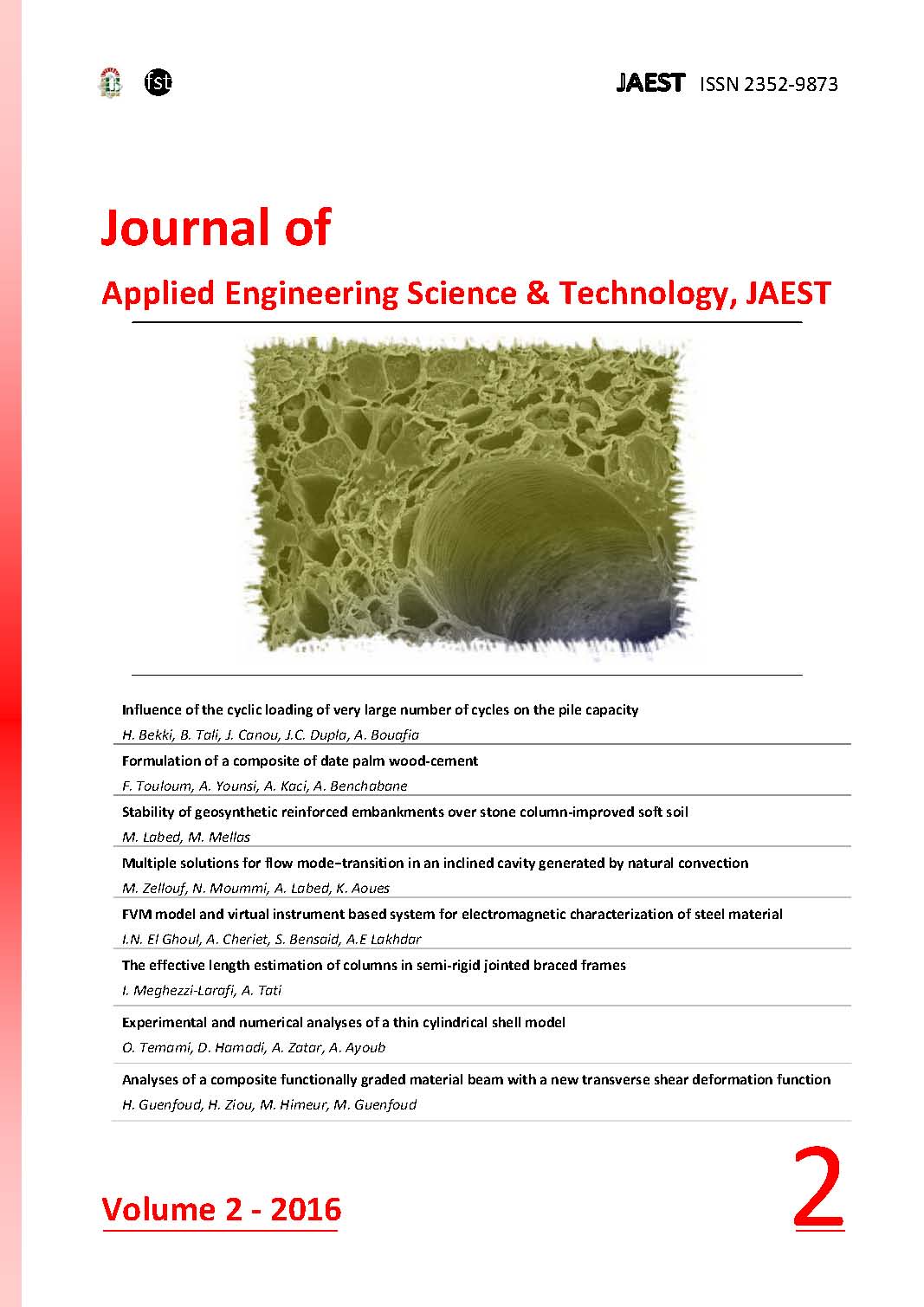DOI:
https://doi.org/10.69717/jaest.v2.i2.43Keywords:
Functionally Graded Material, Power-law, Finite Element Method, Timoshenko’s beam, Shear functionAbstract
In the present paper, we offer a higher-order shear deformation theory for bending of functionally graded beam. A new polynomial shear function is used which satisfies the stress-free boundary conditions (exact boundary conditions on the stress) at both, top and bottom surfaces of the beam. Hence, the shear correction factor is not necessary. Additionally, the present theory has strong similarities with Timoshenko beam theory in some concepts such as equations of movement, boundary conditions and stress resultant expressions. The governing equations and boundary conditions are derived from the principle of minimum potential energy. Functionally graded material FGM beams have a smooth variation of material properties due to continuous (unbroken) change in micro structural details. The variation of material properties is along the beam thickness and assumed to follow a power-law of the volume fraction of the constituents. Finite element numerical solutions obtained with the new polynomial shear function are presented and the obtained results are evaluated versus the existing solutions to verify the validity of the present theory. At last, the influences of power law indicator and the new shear deformation polynomial function on the bending of functionally graded beams are explored.
Downloads
Downloads
Published
Issue
Section
License

This work is licensed under a Creative Commons Attribution-NonCommercial 4.0 International License.
How to Cite
Similar Articles
- Abla Femmam, Abdelhak Mabrouki, Mekki Mellas, Numerical study of the bearing capacity of a strip footing on tow layered clay under inclined loading , Journal of Applied Engineering Science & Technology: Vol. 4 No. 2 (2018): JAEST
- Saida Fedali, Hakim Madani, Cherif Bougriou, Prediction method of both azeotropic and critical points of the binary refrigerant mixtures , Journal of Applied Engineering Science & Technology: Vol. 3 No. 1 (2017): JAEST
- Abdelmadjid Meftah, Naïma Benmebarek, Sadok Benmebarek, Numerical study of the active earth pressure distribution on cylindrical shafts using 2D finite difference code , Journal of Applied Engineering Science & Technology: Vol. 4 No. 2 (2018): JAEST
- Miloud Zellouf, Noureddine Moummi, Adnane Labed, Kamel Aoues, Multiple solutions for flow mode−transition in an inclined cavity generated by natural convection , Journal of Applied Engineering Science & Technology: Vol. 2 No. 2 (2016): JAEST
- Ismail Meghezzi-Larafi, Abdelouahab Tati, The effective length estimation of columns in semi-rigid jointed braced frames , Journal of Applied Engineering Science & Technology: Vol. 2 No. 2 (2016): JAEST
- Sabiha Aklouche‐Benouaguef, Belkacem Zeghmati, Bifurcations in two‐dimensional differentially heated cavity , Journal of Applied Engineering Science & Technology: Vol. 3 No. 1 (2017): JAEST
- Sihem Latreche, Leila Sriti, Improving thermal comfort conditions through the optimization of the self-product residential buildings envelope. Case of a region with a hot and arid climate: Biskra , Journal of Applied Engineering Science & Technology: Vol. 4 No. 2 (2018): JAEST
- Issam Abdesslam, Mekki Mellas, Pushover analysis of the reinforced concrete frames with soft first storey using a fiber hinge model , Journal of Applied Engineering Science & Technology: Vol. 3 No. 2 (2017): JAEST
- Said Khoudiri, Fateh Benchabane, Khaled Yahia, Nonlinear control of a grid connected hybrid energetic systems (HES) based on photovoltaic- fuel cells distributed power generation systems , Journal of Applied Engineering Science & Technology: Vol. 4 No. 1 (2018): JAEST
- Abdelmaek Hasseine, Imane Bechka, Menwer Attarakih, Hans-Jöerg Bart, Applications of He’s methods to the steady-state population balance equation in continuous flow systems , Journal of Applied Engineering Science & Technology: Vol. 3 No. 2 (2017): JAEST
You may also start an advanced similarity search for this article.





